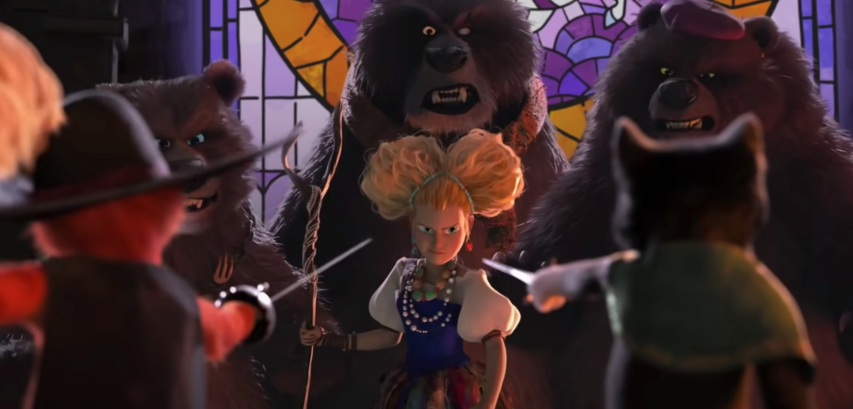There has been a lot of chatter since Puss in Boots: The Last Wish premiered regarding the adapted art style used for the characters in the film (particularly the humans). The primary complaint about the characters’ designs is that they are more traditional aesthetic and marketable- a concept regarding character design that was thrown to the wolves and heavily poked fun at in the DreamWorks Animation Shrek franchise (as evident by the caricature-esque designs), where Puss in Boots first appeared- and thus many fans were caught off guard by the stylistic changes that were made. Now, it may seem silly to complain about character designs for being styled in a way that is more traditionally attractive, but the fault that fans have found is in the contrarian message it sends to audiences about beauty standards.
As I mentioned before, Puss in Boots first appeared on the big screen in the Shrek franchise; his first appearance is as a supporting character in Shrek 2. The whole concept around Shrek, however, that made it such a successful franchise is that it is important to get to know people for who they are beyond superficial appearances in order to see their worth and value. This idea is emphasized throughout the whole film, as the protagonist is an ogre and consequently is perceived by others as being a threat and something to be feared. The film teaches audiences about the importance of taking the time to get to know people and accept each other’s differences. This concept of individuality is incredibly apparent throughout the film, not only in its writing and plot but right down in the vast character designs. Each character resembles a sort of caricature, which, if you don’t know, is a style of art that is used to emphasize different physical attributes in order to help differentiate characters. This style is what gave the Shrek franchise much of its charm and humor. So, in creating character designs to appear more consistent and traditionally attractive (such as giving female characters bigger eyes and smaller body proportions), in a movie centered around a character that has its roots in a style that retaliates against this marketable style reads to some viewers as hypocritical.
While it is a completely valid way to feel about the different artistic choices, I think there are a few additional factors to bear in mind, however, when comparing them to one another- factors- that the majority of viewers likely have not considered. They’re the same franchise, yes, but they are not the same film. They are trying to teach audiences completely different lessons, and so the creators used the storytelling elements differently to meet either film’s needs and reflect this. In Shrek, the caricature style aided the movie as a storytelling device because it more quickly communicated the themes of the film about beauty, flaws, and individuality through additional visual information. Puss in Boots: The Last Wish, however, tells a completely different story. It is a film that teaches audiences about the value of life, the importance of living in the moment, and life to its fullest; it’s about being grateful for what as well as who you have in your life and being brave, and taking chances. A caricature style wouldn’t have helped to communicate to viewers these themes and ideas, as it doesn’t relate to them in the same way that it did to those of the Shrek films. In fact, it’s possible it would have even undercut the important messages of this movie by distracting spectators with visual humor during scenes meant to have substance and emotional impact.
Beyond the mere fact that these are two separate films with different storytelling needs, it is also worth mentioning that Puss in Boots: The Last Wish isn’t Puss in Boots’ first spin-off. The character also had his own Netflix series called The Adventures of Puss in Boots. While it is easy to forget about this series, as little to none of its content made it into the new wildly successful film, it is important to note that the series also had a different visual aesthetic from both films mentioned before. The series’ artistic style is somewhat derivative of both the Shrek films and the new Puss in Boots movie. However, it is still distinctly its own style. The show uses the same concept of caricature-esque stylized characters for the sake of comedy and consistency with its original source material. However, the caricatures have less emphasis on realism and more emphasis on a cartoonish style like that seen in Puss in Boots: The Last Wish. I mention the series because it serves as an important stepping stone between the Shrek films and the new Puss in Boots film. This series is where much of Puss in Boots’ personality was fleshed out and explored, and consequently, the world of Puss in Boots was as well. The artists would be remiss not to have adjusted the style of the characters in the new Puss in Boots film to look, at least in part, like an evolution from the Netflix series. The design changes evolved from those first toyed around within the less popular series, and so Shrek is not the only source material that the film was based on. It had to have stylistic elements of both the series and the Shrek franchise in order to not completely blindside fans that did watch the series, such as myself. While the stylistic changes may feel stark and contrarian for some, it is important to remember that the film is its own piece, with roots spread out across multiple animated works. The art style is a byproduct of adjusting to new themes, audiences, and the influence of contrasting source materials. If you still don’t understand how the art adapted across multiple works, I recommend going back and watching some episodes from The Adventures of Puss in Boots to acquaint yourself with the varied art styles.

